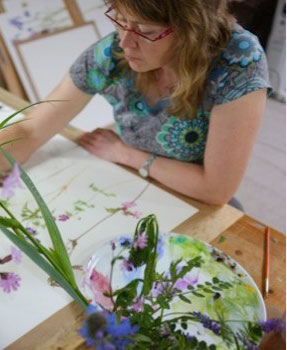Jenny Matthews Artist - Edinburgh, Scotland
When or what made you decide to specialise in painting flowers?
I have had an interest in wild flowers since childhood holidays in the Scottish Highlands. When I was studying Drawing and Painting at Edinburgh College of Art, I chose to take Botanical Illustration as an elective subject. Dame Elizabeth Blackadder taught this at Edinburgh’s Royal Botanic Garden. Therefore much of my work at college was flower-based, and it’s a subject I never tire of. Fortunately people enjoy my paintings, so I am able to pursue this interest.
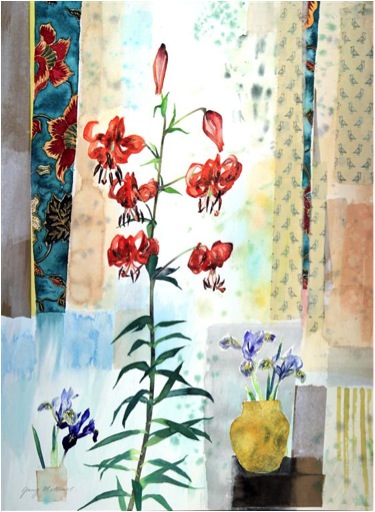
‘A Little Bird Told Me’
As a mother of two and a highly sought after artist, how do you fit it all into 24 hour day?
My studio is on the top floor of our townhouse, so my commute time is very short! Once everyone has gone off in the morning I can go up there to work in peace until late afternoon when the family starts to return. Of course, a typical day is also interspersed with other more domestic duties, but I thrive on limited time and deadlines.
When did you take the risk of turning the pretty into the pretty amazing and developing your own style?
I was fortunate that from my first exhibition during my degree show people were buying my paintings. My style is constantly evolving because I enjoy exploring new ideas and methods. Although I do not seek to paint what I know will sell, I am aware that if I take an avenue which results in me ceasing to sell work, then I cannot justify spending my days creating art which remains unsold. There is a balance between creating intuitively and earning a living. I am fortunate that what I paint does not compel me to live in a garret.

‘Tortoishell and Dahlia’
Can you discuss the ‘splodge’ backgrounds to your work?
Watercolour is a wonderful medium in itself, regardless of the subject matter being described. The effects it creates as it dries are fascinating and it results in curious abstractions. The colours for my backgrounds often come from nature: sky, light effects, combinations of colours glimpsed together … and I like to celebrate the characteristics of watercolour whilst depicting a subject literally.
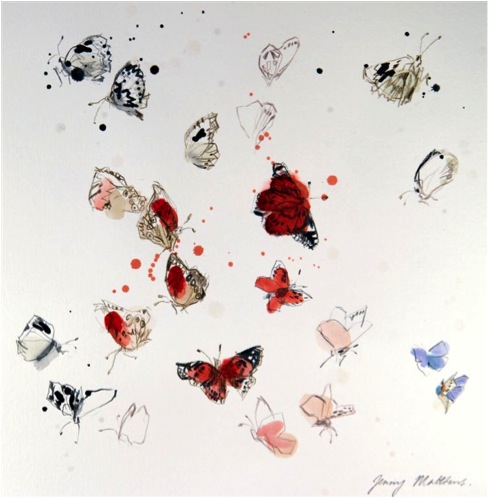
Butterflies –sketches from France with paint
Discuss the composition of two or three paintings?
‘Tarves Sampler’ (63 x 71 cm) is a still life which incorporates a family heirloom. This sampler was stitched in 1866 by my great grandmother who lived in Aberdeenshire in a small village called Tarves. I am always on the lookout for interesting bits and pieces which can spark an idea. My still lives are not literally set up in front of me as I work, but the components are put down in a sketch and brought together using colour, in this case coming from the sampler, to become a painting. ‘Tarves Sampler’ was painted in the spring, so I used some early miniature irises which I had in the studio to accompany the sampler.

‘Traves Sampler’
‘Flight of the Butterflies’ (90 x 120 cm) shows some life size irises from my garden. I never work from photographs, so sometimes I either cut the flowers and bring them into the studio, or work outside, depending on the weather of course. Here, I experimented with some graphite pencil in the background to create some texture.

‘Flight of the Butterflies’
‘Knock Me Down with a Feather’ (63 x 53cm) was for an exhibition called ‘In the Company of Birds’ in central Edinburgh. I explored various themes to do with birds, including feathers. Because I was outdoors looking for feathers, wild flowers seemed a natural choice to be included. These flowers were all sketched in Scotland.
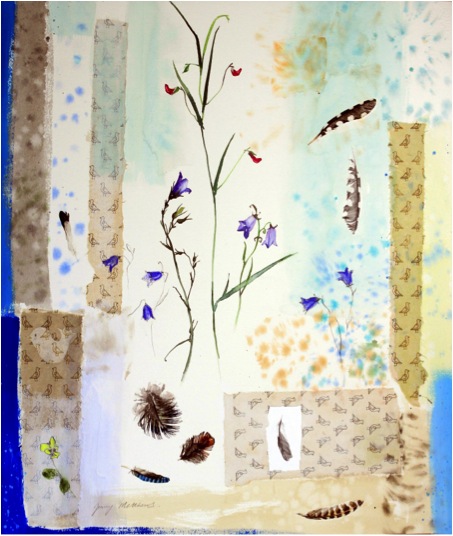
’Knock Me Down with a Feather’
‘Wet Weather Tulips’ (86 x118 cm). This painting of life-size tulips was created from some paintings I made in the garden in 2012. It was a very wet spring and a bad year for tulips. The background represents the showers of rain which cut short my painting!

‘Wet Weather Tulips’
You also travel – how do you record during your travel?
One of my current interests is butterflies and insects and I take a small cartridge sketch book and coloured pencils with me when I go travelling, not to mention my binoculars. Sometimes I visit an area with the intention of finding subjects: wildlife reserves for example, although we have very few species of butterfly in Scotland. In the summer of 2013 in France I spent a lot of time sketching butterflies and saw about 12 ‘new’ ones: capturing their movements and attitudes is important, and I try to do as many sketches as I can so that I have plenty of material to use later in paintings.

Butterfly sketches in France
If heading out to neighbours’ gardens can also be considered ‘travel’, then I take an Imperial sized piece of watercolour paper prepared on a board, my paints and palette and a stool to paint on location. I have a friend close by who has an enormous collection of tulips which fill her garden every May. If I’m out walking in the hills then I will usually have a sketch book and binoculars in case I see something interesting.

Ann’s Garden
You do many commissions. Can you discuss how you have developed this part of your work?
Commissions form an important part of my work and they are requests from people who have a space to fill of a particular size/ want their collection of garden flowers brought together in one painting/ have seen a painting which has already sold or have a favourite flower they wish depicted. The commissions are very often to be gifts for weddings or special birthdays. However, customers are never obliged to purchase the finished painting if they are in any way disappointed, so this removes a potential obstacle.
Many would not expect that you would do commission of wedding Bouquets and other simple domestic requests, explain this aspect of your commissions?
I enjoy the challenge of finding a way to fulfil a customer’s requests while remaining true to myself. Occasionally I have been asked to paint something which I’m not comfortable with and in this case I don’t accept the commission: I need to be able to create a painting which is still a ‘Jenny Matthews’, and that is normally what the client wishes too so they’re never too prescriptive in their brief. It’s interesting to discover what people are looking for in a painting, and to be party to that.
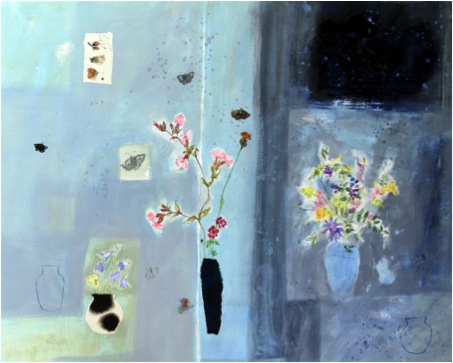
‘Wild Bouquet Strathdon’
You say you don’t like ‘bitty flowers’ – can you expand on this comment?
I am attracted to flowers with strong silhouettes and forms. I will sometimes incorporate a ‘bitty’ flower, for example Forget Me Not, into a painting, and the juxtaposition of different scales and forms can work really well in a composition, but if I painted only what I am attracted to then I would always go for irises or tulips and other bold forms! Wild flowers tend to be ‘bitty’ too, but I love painting them.
Discuss the influence Dame Elizabeth Blackadder has had on your work as a tutor and mentor?
Elizabeth lives in Edinburgh, as I do, and I remember when I first heard of her when I was still at high school. Subsequently, when I was at art college, I was steered towards her botanical illustration course. From then on she was hugely influential to me: not only because she worked alongside us as we worked, but also because she uses watercolour which I love above all other media. Elizabeth unashamedly paints beautiful things for their own sake, and creates decorative images which give pleasure to the viewer, and I admire that. She is also someone I can get along with and feel comfortable with, which obviously helps.
You are not restricted to the demands of formal botanical painting. Can you discuss this?
Botanical artists are required to measure and record with perfect accuracy the flowers they paint. Their work is used in identification, so accuracy is of the utmost importance. What I enjoy is the ‘character’ of the plant, and trying to record my response to it.
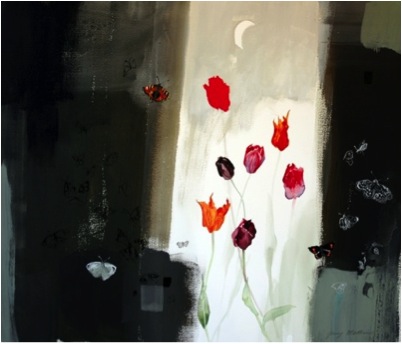
‘One Moth’
You are not afraid to leave the ink and crayon marks on your work rather allowing these to take a part in your work, explain this?
What I like to see in a piece is how it came into being: the process and some evidence of the creator’s hand. It’s ‘paint’ as well as ‘a painting’.
You now also teach. Can you expand on your teaching?
I have actually given up teaching in any regular way. I don’t really have time any more, although I do occasionally give one-to-one tutorials in my studio. I used to teach adult classes in Botanical painting, watercolour and drawing in the days when I had more time and less success (or should that be children?)!
Do you exhibit beyond the UK?
Not yet! Exhibiting beyond the UK is an ambition of mine and something which I am pursuing! Any suggestions?
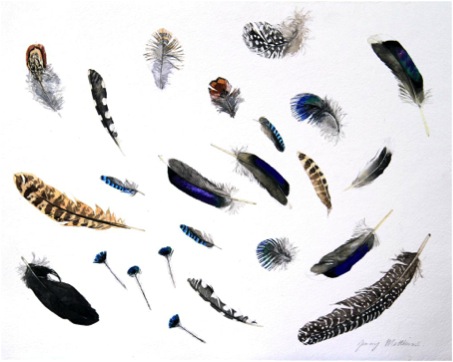
‘Birds of a Feather’
Do you see a strong relationship between the fragility of watercolour and flowers?
This is me speaking as a Scot in a Scottish climate! However, I do feel that watercolour lends itself to the depiction of flowers more than other media.
Your format is not in bowls rather as if the flowers have just been picked and scattered on the table. Explain this approach?
It’s a continuation of botanical illustration, with my own take on the tradition. Durer, one of my favourite artists, did the same. I like the idea of painting a flower’s portrait.
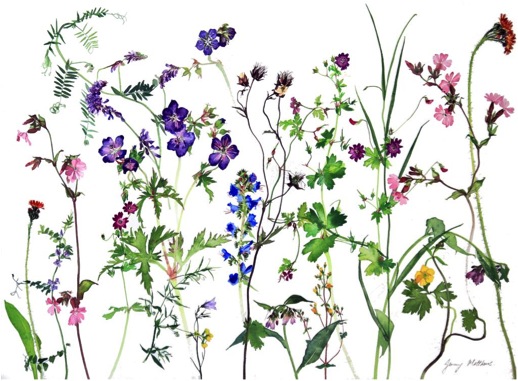
‘Where the Wild things Grow’
Contact details:
jennymatthews@blueyonder.co.uk
www.jennymatthews.co.uk
Jenny Matthews, Edinburgh, Scotland
Interview by Deborah Blakeley, November 2013
Think a colleague or friend could benefit from this interview?
Knowledge is one of the biggest assets in any business. So why not forward this on to your friends and colleagues so they too can start taking advantage of the insightful information the artist has given?
Other artists you may be interested in:


